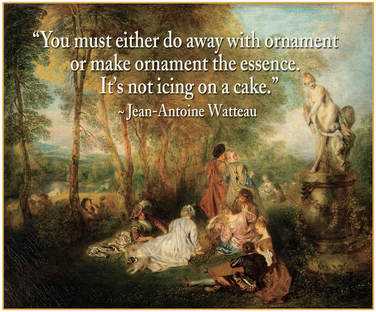|
Joan M. Rehlin
Another of our mini art history posts... Jean-Antoine Watteau (October 10, 1684–July 18, 1721), known as Antoine Watteau, was a French painter and one the leading Rococo artists of the 18th century. Watteau shifted the waning Baroque style to the less formally classical, more naturalistic, witty, and playful Rococo style, which is considered a major period in the development of European art. Although Watteau’s father expected his son to follow him into the construction field, Watteau showed an early talent in painting. At the age of 18, he moved to Paris where he found employment and honed his artistic talents at several studios, developing a style of drawing that was admired for its sophisticated elegance. Watteau’s major influences included Peter Paul Rubens’ series of elaborate canvases created for Queen Marie de Medici, as well as the work of the Venetian masters. Watteau was admitted to the French Academy and is credited with inventing the fêtes galantes genre, a term coined in 1717 by the Academy to describe Watteau’s bucolic, idyllic scenes that include a flair for the dramatic. Watteau’s paintings detail not only theatrical flamboyance but also a wistfulness regarding the transience of love and other earthly delights, a dichotomy Watteau understood all too well. Although surrounded by riches, coquetry, and elegance, Watteau didn’t partake of this charmed world due mostly to having contracted tuberculosis, the disease that took his life when he was only 36. More than most other 18th century artists, Watteau is celebrated now as having influenced every aspect of art during the Rococo period, including painting, costumes, interior design, plays, and music. Watteau’s The Feast of Love is currently in the Old Masters Gallery in Dresden, Germany. The Feast of Love, oil painting, c. 1718–1719, Jean-Antoine Watteau
0 Comments
Leave a Reply. |
ART BLOGWelcome to our Art Blog where we occasionally present topics of interest in the fine art world, including featuring artists other than Jim Rehlin. Some of the artwork has been created by long-departed but well-known greats; some, by compelling contemporary artists. All will be pieces we find worthwhile to share with you. If you like any of these, consider sharing the posts forward to your own blogs and other social media. |
|
Artwork by Jim Rehlin.
Website content and modifications ©2024 Rehlin Graphics / Fine Art. All rights reserved. Click HERE to Visit and Like Rehlin Graphics / Fine Art on Facebook. THANKS! |

 RSS Feed
RSS Feed
